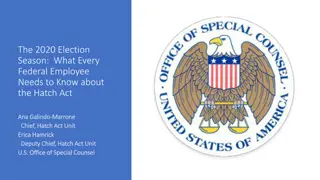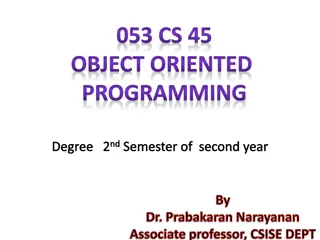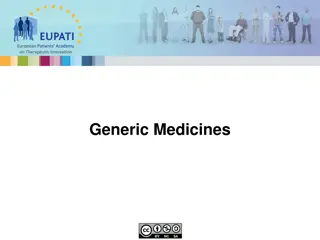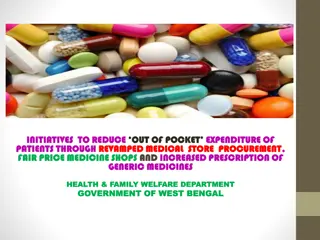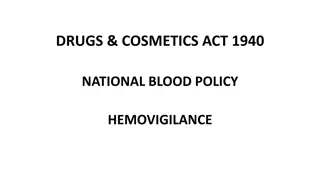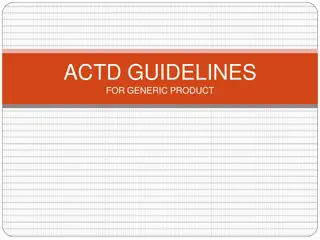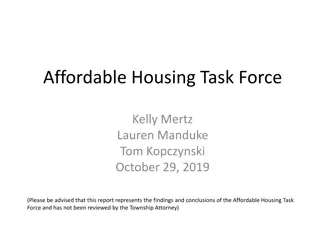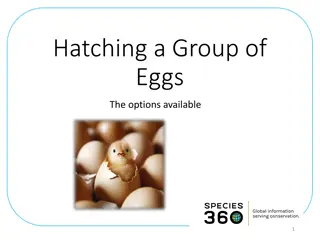Understanding the Hatch-Waxman Act: Promoting Affordable Generic Drugs
The Hatch-Waxman Act, also known as The Drug Price Competition and Patent Term Restoration Act, was enacted in 1984 to amend patent laws and the Federal Food, Drug, and Cosmetic Act. It aims to reduce costs associated with generic drug approval, allow early experimental use, compensate branded drug manufacturers for lost patent time, and motivate generic drug manufacturers. The Act seeks to balance the interests of all stakeholders involved in the pharmaceutical industry.
Download Presentation

Please find below an Image/Link to download the presentation.
The content on the website is provided AS IS for your information and personal use only. It may not be sold, licensed, or shared on other websites without obtaining consent from the author. Download presentation by click this link. If you encounter any issues during the download, it is possible that the publisher has removed the file from their server.
E N D
Presentation Transcript
CONTENTS Introduction 1 Objectives of theAct 2 Provisions of theAct 3 Para IVFilings 4 Delay in generic entry(Reverse payment agreements) 5 Loopholes of theAct(Authorized generics) 6 Conclusion 7
INTRODUCTION Also known as The Drug Price Competition and Patent Term Restoration Act Enacted in 1984 Amended the Patent laws Amended the Federal Food, Drug, and Cosmetic Act Before 1962- new drug approved based on safety alone 1962- Proof of efficacy made compulsory for marketing approval of a new drug (Kefauver-Harris Amendments)
INTRODUCTION CONTD There was no provision for patent term extension prior to enactment of the Hatch Waxman Act, to make up for the time lost out of the total patent term during the marketing approval process Generic companies required to submit their own comprehensive NDA Costly Time consuming If drug was covered by patent Testing could not begin until patent expired To overcome the above problems an act was needed to promote generic companies
OBJECTIVES OF THEACT Reducing the cost associated with the approval of a generic drug Allowing Early-Experimental-Use Compensating the branded drugs manufacturers for the time lost from the patent term because of the regulatory approval formality Motivating the generic drug manufacturers HWA strives to strike a balance between the interests of branded drug manufacturers, generic drug manufacturers and the consumers
PROVISIONS OF THEACT Creation of section 505(j) Section 505(j) established the ANDAapproval process The timing of an ANDA approval depends in part on patent protections for the innovator drug NDA must include any patent that claims the "drug" or a "method of using [the] drug" for which a claim of patent infringement could reasonably be asserted On approval of NDA, FDA publishes patent information for drug in Orange Book ( Approved Drug Products with Therapeutic Equivalence Evaluations )
PROVISIONS OF THEACT ORANGEBOOK FDA publishes patent information on approved drug products in the Orange Book An NDA applicant must submit the following information for each patent: Patent no and date on which the patent will expire Type of patent, i.e. drug, drug product, or method of use Name of patent owner The name of an agent of the patent owner or applicant Brand drugs listed for generics to compare with their proposed products
PROVISIONS OF THEACT Four Types of Patent Certifications When an applicant submits an ANDA to the FDA, the applicant must certify one of four things under section 505(j)(2)(A)(vii): that the required patent information relating to such patent has not been filed (Para I) ; that such patent has expired (Para II) ; that the patent will expire on a particular date ( Para III); that such patent is invalid or will not be infringed by the drug, for which approval is being sought (Para IV Patent Challenge)
PARA IV- PATENT CHALLENGE GENERIC-PARA IVFILING GENERIC-PROVIDE NOTICE TO BRAND WITHIN 20 DAYS OFACCEPTANCE BRAND-MUST BRING LAWSUIT WITHIN 45 DAYS GENERIC-IF SUED, AUTOMATIC 30 MONTH ST A Y GRANTED TOBRAND
INCENTIVES AND PROTECTION 180 Day Marketexclusivity First applicant to submit a substantially complete ANDA (first-to-file) May be shared by multiple applicants Subject to forfeiture 30-month stay of FDAapproval If patent owner or NDA holder sues the ANDA applicant for patent infringement within 45 days of receiving notice of the Paragraph IVcertification Runs from date of notification or expiration of NCE exclusivity May be lengthened or shortened by the court
PARA IVDEADLINES NOTIFICATION LETTER: 20 DAYS Upon ANDA acceptance for filing, the applicant must notify the NDA holder and patent owner of the ANDA within 20 days. The notice must include a detailed statement of the factual and legal basis of the opinion of the applicant that the patent is invalid or will not be infringed LAWSUIT: 45 DAYS Upon notification, the NDA holder and patent owners have 45 days in which to initiate an action for patent infringement. If such an action is brought within 45 days, the ANDA is subject to a 30-month stay of FDA approval beginning on the date the notification letter was received
ANDA APPROVAL & INDIANCOMPANIES Drug approvals inUS 2009 19 2010 18 18 17 17 15 12 11 11 3 Glenmark Aurobindo Sun Lupin DRL Indian companies bagged 33.17% or 139 of 419original ANDA approvals from US FDA in 2010 Source: http://www.business-standard.com/india/news/indian-pharma-remains- top-in-us-generics/420523/
EXEMPT ACTS OF PATENT INFRINGEMENT FOR FDA APPROVAL The manufacture, use, or sale of a patented drug is not an act of infringement, to the extent it is necessary for the preparation and submission of an ANDA The Hatch-Waxman Act provides under 35 U.S.C. 271(e)(1), generally that: It shall not be an act of infringement to make, use, or sell a patented invention solely for uses reasonably related to the development and submission of information under a Federal law which regulates the manufacture, use, or sale of drugs.
HATCH WAXMAN TRADE-OFF BRANDS GENERICS BRAND- 30 MONTH STAY GENERIC- 180 DAY EXCLUSIVITY 1st successful Para IV filer A big head start on others Automatic Injunction Notice of generic competition Can be worth $$ mn per day
HATCH WAXMAN TRADE-OFF BENEFITS FOR BRANDEDMANUFACTURERS Orange Book provides public notice of patents Allows for resolution of patent disputes prior to generic entry 30-month stay of FDA approval of generic drugs Patent Term Restoration Allows for Several Market Exclusivities: Data Exclusivity 5 years for New Chemical Entity (NCE) Drug 3 years for non-NCE Drug Orphan Drug (7 years) Pediatric (PEDS) (6 months)
HATCH WAXMAN TRADE-OFF BENEFITS FOR GENERICMANUFACTURERS 180-day market exclusivity for first successful challenger to Orange Book patent Allows generics to challenge Orange Book patents without risk of damages Safe Harbor rule allows generics to perform bioequivalence and other testing relating to regulatory approval without risk of patent infringement Dr Reddy s was the first Indian company to get the180-day exclusivity for marketing Fluoxetine (Eli Lilly s Prozac) 40 mg capsule in August2001
NON-PATENT EXCLUSIVITY Types Term New chemical entity 5 years New Clinical study 3 years Orphan drug 7 years Pediatric exclusivity 6 months 180-day generic market exclusivity 180 days
NEW CHEMICAL ENTITYEXCLUSIVITY Hatch-Waxman Act, 1984 Granted: to drug products containing a New Chemical Entity Blocks: submission of 505(b)(2) or ANDA Length: five years (or four years if para. IV)
NEW CHEMICAL ENTITY DEFINITIONS New Chemical Entity: a drug that contains no active moiety that has been approved by FDA in any other application submitted under section 505(b) of the act Active Moiety: appended portions of the molecule that cause the drug to be an ester, salt (including a salt with hydrogen or coordination bonds), or other noncovalent derivative (such as a complex, chelate, or clathrate) of the molecule, responsible for the physiological or pharmacological action of the drug substance the molecule or ion, excluding those
NCE EXCLUSIVITY FORENANTIOMERS Federal Drug Administration Amendments Act, 2007( FDAAA ) Under strict conditions, an enantiomer can qualify as a NCE: The single enantiomer has not been previously approved except in the approved racemic drug The NDA includes full new clinical investigations The clinical studies were not used for the racemate The enantiomer indication is not in the same therapeutic category as the racemate Three-year exclusivity available: e.g., Lexapro(escitalopram); Nexium (esomeprazole)
NEW CLINICAL STUDY EXCLUSIVITY Hatch-Waxman Act, 1984 Granted: for submission of results of new clinical studies Blocks: approval of 505(b)(2) or ANDA Length: three years
NEW CLINICAL STUDY EXCLUSIVITY Granted for submission of reports of new clinical investigations (other than biovailability studies) essential to the approval of the application [or the supplemental application] and conducted or sponsored by the applicant Examples: new or changed formulations; salts; indications; dosing regimens; patient populations; OTC switches; or other label changes Opana ER (immediate release extended release) Caduet (atorvastatin/amlodipine combination)
ORPHAN DRUGEXCLUSIVITY Orphan Drug Act, 1983 Granted: to drugs intended for treatment of a rare disease or condition Affects < 200,000 people in the U.S., or No reasonable expectation of recouping dev. costs Blocks: approval of 505(b)(1), (b)(2), or ANDA directed to the same drug, for same disease Length: seven years Additional rewards: tax credits; grants; fees waived
PEDIATRIC EXCLUSIVITY Food and Drug Administration Modernization Act, 1997 ( FDAMA ) Granted: to applicants who successfully complete FDA-requested clinical trials of a drug in a pediatric population Blocks: approval of 505(b)(2) or ANDA Length: six months beyond any existing marketing or patent exclusivity gov t funding of pediatric studies if no exclusivity
GENERIC DRUGEXCLUSIVITY Hatch-Waxman Act, 1984 Granted: to first ANDA applicant who submits a substantially complete ANDA containing a paragraph IV certification Substantially complete = sufficient to permit review Blocks: approval of subsequently-filed ANDA containing a paragraph IV certification Length: 180 days, from commercial marketing
180-DAY EXCLUSIVITY FORFEITURE Medicare Modernization Act, 2003 ( MMA ) Six ways to forfeit: 1. failure to market 2. withdrawal of application 3. amendment of certification 4. failure to obtain tentative approval within 30 mos. 5.improper agreement with another applicant, the listed drug application holder, or a patent owner 6. expiration of all patents
DELAY IN GENERIC ENTRY Reverse PaymentAgreements Sham Litigations(30 monthsstay) Sham Citizen s Petitioning Walker ProcessFraud Product Hopping
REVERSE PAYMENT AGREEMENTS Both parties decide it is in their mutual best interests to settle via a significant payment from the patent owner/branded to the generic to keep the generic drug off the market The generic may make more by rushing to market the drug The branded may also make more money by paying the generic to defer marketing the drug for a certain period of time money than
REVERSE PAYMENT AGREEMENTS Intellectual property licenses Distribution agreements Co-promotion arrangements Side deals Development agreements Supply agreements Noauthorized generic
REVERSE PAYMENT AGREEMENTS CASESTUDY FTC vs. Cephalon (E.D. Pa.) (filed Feb. 13, 2008 ) Provigil -$800 million brand sales 6 years delayed entry Complaint alleges that Cephalon unlawfully induced four first filers to refrain from marketing generic Provigil until 2012 by entering into over 13 side deals that transferred substantial value to the generics
FTC V. CEPHALON, INC. Settlements Allegedly Delay Entry By 6 Years
FTC V. CEPHALON, INC. SETTLEMENT TERMS ANDTIMELINE
REVERSE PAYMENT AGREEMENTS MMA Patent Settlement Filing Requirements Pharmaceutical patent settlements required to be filed with FTC (per 2003 Medicare Modernization Amendments) Why Congress Enacted This Requirement Waxman: to re-emphasize the Hatch-Waxman Act s original intent of enhancing competition, not collusion, between generic and name-brand drug manufacturers
BMS/APOTEX SETTLEMENT ON PLAVIX Settlements at Issue Original Settlement FTC did not approve because included provision that BMS would not launch authorized generic Revised Settlement Did not include authorized generic provision, but BMS orally represented it would not launch authorized generic Both Settlements Submitted to FTC Required under prior BMS consent, which required FTCapproval Required under MMA filing requirement Apotex submitted letter with MMA filing noting oral terms BMS signed FTC certification confirming no oral terms Ramifications for BMS DOJ Criminal Investigation and Plea Agreement with BMS (two felony counts and criminal fine of $1 million) BMS Senior VP Andrew Bodnar ($100,000 fine, one year jail time, required to write book on experience) State Attorneys General ($1.1 million fine for misleading States regarding settlement (violation of 2003 Order with States)) FTC ($2.1 million in civil penalties for misleading FTC regarding settlement (violation of 2003 FTC Order and MMA violation))
SHAM LITIGATION Brand sues generic for patent infringement Court finds for generic, often on SJ, and holds patent invalid or unenforceable Hatch-Waxman 30-month stay allows brand to win even if they lose Plaintiffs must prove brand s infringement suit is objectively and subjectively baseless
SHAM CITIZENPETITIONING Companies can petition FDA to not approve an ANDA Should be based on safety or formulation concerns Citizen s Petitions delay approval of ANDAs Ripe for abuse, and often abused Delay itself is the goal Same standard as Sham Litigation
WALKER PROCESSFRAUD Antitrust violation premised on fraud on the PTO Patent applicants have a duty of candor to PTO because applications are ex parte Elements track fraud claims Often coupled with Sham Litigation and other theories
PRODUCT HOPPING Delay sometimes allows brands to introduce new versions of the product Changes are often minimal but can defeat generic competition Brands actively convert the market Free samples Pulling the old product from the market
LOOPHOLES IN THE HATCH-WAXMAN ACT Authorizedgenerics 30 month stay Warehousing patents Reversepayments Citizen s petitions
AUTHORIZED GENERICS(AG) AGs are pharmaceutical products that are approved as brand-name drugs but marketed as generic drugs AGs do not bear the brand-name or trademark of the brand-name drug or manufacturer, but the brand- name and AG products are manufactured to the brand s specifications Authorized generics have a unique impact during the first six months of generic competition Competition from AGs during the 180 -day exclusivity period has the potential to reduce both generic drug prices and generic firm revenues
AUTHORIZED GENERICS(AG) Drug: Nitrofurantoin Innovator: P&G AG: Watson Generic: Mylan Mylan lost about $30 mn of the revenue it was set to realize under its 180-day exclusivity grant from FDA
INDIAN COMPANIES & AUTHORIZEDGENERICS Femcon Fe (WarnerChilcot) Lupin 2011 Rocaltrol (Validus) Ranbaxy 2009 Caduet (Pfizer) Ranbaxy 2011 Zocor (Merck) DRL 2006
WAREHOUSING PATENTS Evergreening or warehousing of patents An innovator may patent multiple attributes of a product (may be color, manufacturing process or the chemicals produced when the drug is ingested in the body) and keeps on adding patents in the Orange Book, essentially forcing the generic to hose between waiting for the patents to expire or file a Para IV certification which brings along the risks of litigation and associated costs and delays The provision of filing a patent infringement lawsuit gives the brand name manufacturer at least an additional two and a half years of product monopoly has resulted in a wave of such lawsuits
CONCLUSION The Hatch Waxman Act extended the life of the pharmaceutical patents up to 14 years from the time the New Drug Application is approved by the FDA, provided additional market exclusivity for the new uses or new formulations, allowed potential generic manufacturers to conduct work related to marketing approval of the drug without the charge of patent infringement, permitted generic manufacturers to use safety and effectiveness research performed by the brand name pharmaceutical companies, introduced the concept of bioequivalence to obtain the approval of generic drug, and simplified generic drug approval process by introducing ANDA, and encouraged patent challenges by providing 180 -day market exclusivity for the first generic manufacturer who files ANDA
CONCLUSION CONTD Hatch Waxman Act led to the birth of generic industry It also gave protection to innovators in terms of 30 month stay, market exclusivities and patent term extensions But, the brand companies are taking advantage of the loopholes of HWA in the form of authorized generics and reverse payment agreements Brand companies are also involved in sham litigations to take advantage of 30 month stay provision Role of both brand and generic companies are vital for US healthcare system Maintaining the balance between these two important contributors to health care will be essential in meeting the goals of affordable health care and innovative research



